+ Open data
Open data
- Basic information
Basic information
| Entry | Database: PDB / ID: 8j8v | |||||||||||||||
|---|---|---|---|---|---|---|---|---|---|---|---|---|---|---|---|---|
| Title | Structure of beta-arrestin2 in complex with D6Rpp (Local Refine) | |||||||||||||||
 Components Components |
| |||||||||||||||
 Keywords Keywords |  SIGNALING PROTEIN/IMMUNE SYSTEM / SIGNALING PROTEIN/IMMUNE SYSTEM /  GPCR / GPCR /  Arrestin / Arrestin /  SIGNALING PROTEIN / SIGNALING PROTEIN /  SIGNALING PROTEIN-IMMUNE SYSTEM complex SIGNALING PROTEIN-IMMUNE SYSTEM complex | |||||||||||||||
| Function / homology |  Function and homology information Function and homology information angiotensin receptor binding / angiotensin receptor binding /  chemokine receptor activity / desensitization of G protein-coupled receptor signaling pathway / C-C chemokine receptor activity / chemokine receptor activity / desensitization of G protein-coupled receptor signaling pathway / C-C chemokine receptor activity /  inositol hexakisphosphate binding / C-C chemokine binding / scavenger receptor activity / G protein-coupled receptor internalization / Chemokine receptors bind chemokines / phosphatidylinositol-3,4,5-trisphosphate binding ... inositol hexakisphosphate binding / C-C chemokine binding / scavenger receptor activity / G protein-coupled receptor internalization / Chemokine receptors bind chemokines / phosphatidylinositol-3,4,5-trisphosphate binding ... angiotensin receptor binding / angiotensin receptor binding /  chemokine receptor activity / desensitization of G protein-coupled receptor signaling pathway / C-C chemokine receptor activity / chemokine receptor activity / desensitization of G protein-coupled receptor signaling pathway / C-C chemokine receptor activity /  inositol hexakisphosphate binding / C-C chemokine binding / scavenger receptor activity / G protein-coupled receptor internalization / Chemokine receptors bind chemokines / phosphatidylinositol-3,4,5-trisphosphate binding / positive regulation of receptor internalization / endocytic vesicle / inositol hexakisphosphate binding / C-C chemokine binding / scavenger receptor activity / G protein-coupled receptor internalization / Chemokine receptors bind chemokines / phosphatidylinositol-3,4,5-trisphosphate binding / positive regulation of receptor internalization / endocytic vesicle /  clathrin-coated pit / clathrin-coated pit /  phosphatidylinositol binding / cell chemotaxis / phosphatidylinositol binding / cell chemotaxis /  actin filament / calcium-mediated signaling / actin filament / calcium-mediated signaling /  receptor internalization / recycling endosome / receptor internalization / recycling endosome /  protein transport / positive regulation of cytosolic calcium ion concentration / protein transport / positive regulation of cytosolic calcium ion concentration /  nuclear membrane / positive regulation of ERK1 and ERK2 cascade / molecular adaptor activity / nuclear membrane / positive regulation of ERK1 and ERK2 cascade / molecular adaptor activity /  early endosome / intracellular signal transduction / early endosome / intracellular signal transduction /  immune response / immune response /  inflammatory response / external side of plasma membrane / intracellular membrane-bounded organelle / inflammatory response / external side of plasma membrane / intracellular membrane-bounded organelle /  signal transduction / signal transduction /  nucleoplasm / nucleoplasm /  nucleus / nucleus /  plasma membrane / plasma membrane /  cytosol / cytosol /  cytoplasm cytoplasmSimilarity search - Function | |||||||||||||||
| Biological species |   Bos taurus (cattle) Bos taurus (cattle)  Mus musculus (house mouse) Mus musculus (house mouse)  Homo sapiens (human) Homo sapiens (human) | |||||||||||||||
| Method |  ELECTRON MICROSCOPY / ELECTRON MICROSCOPY /  single particle reconstruction / single particle reconstruction /  cryo EM / Resolution: 3.22 Å cryo EM / Resolution: 3.22 Å | |||||||||||||||
 Authors Authors | Maharana, J. / Sarma, P. / Yadav, M.K. / Chami, M. / Banerjee, R. / Shukla, A.K. | |||||||||||||||
| Funding support |  India, 4items India, 4items
| |||||||||||||||
 Citation Citation |  Journal: Science / Year: 2024 Journal: Science / Year: 2024Title: Molecular insights into atypical modes of β-arrestin interaction with seven transmembrane receptors. Authors: Jagannath Maharana / Fumiya K Sano / Parishmita Sarma / Manish K Yadav / Longhan Duan / Tomasz M Stepniewski / Madhu Chaturvedi / Ashutosh Ranjan / Vinay Singh / Sayantan Saha / Gargi ...Authors: Jagannath Maharana / Fumiya K Sano / Parishmita Sarma / Manish K Yadav / Longhan Duan / Tomasz M Stepniewski / Madhu Chaturvedi / Ashutosh Ranjan / Vinay Singh / Sayantan Saha / Gargi Mahajan / Mohamed Chami / Wataru Shihoya / Jana Selent / Ka Young Chung / Ramanuj Banerjee / Osamu Nureki / Arun K Shukla /      Abstract: β-arrestins (βarrs) are multifunctional proteins involved in signaling and regulation of seven transmembrane receptors (7TMRs), and their interaction is driven primarily by agonist-induced receptor ...β-arrestins (βarrs) are multifunctional proteins involved in signaling and regulation of seven transmembrane receptors (7TMRs), and their interaction is driven primarily by agonist-induced receptor activation and phosphorylation. Here, we present seven cryo-electron microscopy structures of βarrs either in the basal state, activated by the muscarinic receptor subtype 2 (M2R) through its third intracellular loop, or activated by the βarr-biased decoy D6 receptor (D6R). Combined with biochemical, cellular, and biophysical experiments, these structural snapshots allow the visualization of atypical engagement of βarrs with 7TMRs and also reveal a structural transition in the carboxyl terminus of βarr2 from a β strand to an α helix upon activation by D6R. Our study provides previously unanticipated molecular insights into the structural and functional diversity encoded in 7TMR-βarr complexes with direct implications for exploring novel therapeutic avenues. | |||||||||||||||
| History |
|
- Structure visualization
Structure visualization
| Structure viewer | Molecule:  Molmil Molmil Jmol/JSmol Jmol/JSmol |
|---|
- Downloads & links
Downloads & links
- Download
Download
| PDBx/mmCIF format |  8j8v.cif.gz 8j8v.cif.gz | 225.9 KB | Display |  PDBx/mmCIF format PDBx/mmCIF format |
|---|---|---|---|---|
| PDB format |  pdb8j8v.ent.gz pdb8j8v.ent.gz | 176.5 KB | Display |  PDB format PDB format |
| PDBx/mmJSON format |  8j8v.json.gz 8j8v.json.gz | Tree view |  PDBx/mmJSON format PDBx/mmJSON format | |
| Others |  Other downloads Other downloads |
-Validation report
| Arichive directory |  https://data.pdbj.org/pub/pdb/validation_reports/j8/8j8v https://data.pdbj.org/pub/pdb/validation_reports/j8/8j8v ftp://data.pdbj.org/pub/pdb/validation_reports/j8/8j8v ftp://data.pdbj.org/pub/pdb/validation_reports/j8/8j8v | HTTPS FTP |
|---|
-Related structure data
| Related structure data |  36081MC 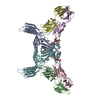 8go9C 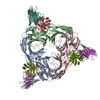 8j8rC 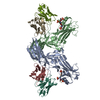 8j8zC 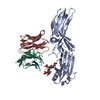 8j97C 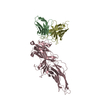 8j9kC 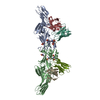 8ja3C 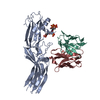 8jafC M: map data used to model this data C: citing same article ( |
|---|---|
| Similar structure data | Similarity search - Function & homology  F&H Search F&H Search |
- Links
Links
- Assembly
Assembly
| Deposited unit | 
|
|---|---|
| 1 |
|
- Components
Components
| #1: Protein |  Arrestin beta 2 / Arrestin beta-2 / Arrestin-3 Arrestin beta 2 / Arrestin beta-2 / Arrestin-3Mass: 47217.676 Da / Num. of mol.: 2 Mutation: C17G,C60V,L69V,C126S,C141L,C151V,C243V,C252V,C270S,L278F,S280A Source method: isolated from a genetically manipulated source Source: (gene. exp.)   Bos taurus (cattle) / Gene: ARRB2 / Production host: Bos taurus (cattle) / Gene: ARRB2 / Production host:   Escherichia coli (E. coli) / References: UniProt: P32120 Escherichia coli (E. coli) / References: UniProt: P32120#2: Antibody | Mass: 25512.354 Da / Num. of mol.: 2 Source method: isolated from a genetically manipulated source Source: (gene. exp.)   Mus musculus (house mouse) / Production host: Mus musculus (house mouse) / Production host:   Escherichia coli (E. coli) Escherichia coli (E. coli)#3: Antibody | Mass: 23435.064 Da / Num. of mol.: 2 Source method: isolated from a genetically manipulated source Source: (gene. exp.)   Mus musculus (house mouse) / Production host: Mus musculus (house mouse) / Production host:   Escherichia coli (E. coli) Escherichia coli (E. coli)#4: Protein/peptide | Mass: 2352.668 Da / Num. of mol.: 2 / Fragment: C-terminal tail / Source method: obtained synthetically / Source: (synth.)   Homo sapiens (human) / References: UniProt: O00590 Homo sapiens (human) / References: UniProt: O00590Has ligand of interest | N | |
|---|
-Experimental details
-Experiment
| Experiment | Method:  ELECTRON MICROSCOPY ELECTRON MICROSCOPY |
|---|---|
| EM experiment | Aggregation state: PARTICLE / 3D reconstruction method:  single particle reconstruction single particle reconstruction |
- Sample preparation
Sample preparation
| Component |
| ||||||||||||||||||||||||||||||
|---|---|---|---|---|---|---|---|---|---|---|---|---|---|---|---|---|---|---|---|---|---|---|---|---|---|---|---|---|---|---|---|
| Molecular weight | Experimental value: NO | ||||||||||||||||||||||||||||||
| Source (natural) |
| ||||||||||||||||||||||||||||||
| Source (recombinant) |
| ||||||||||||||||||||||||||||||
| Buffer solution | pH: 7.4 | ||||||||||||||||||||||||||||||
| Buffer component |
| ||||||||||||||||||||||||||||||
| Specimen | Embedding applied: NO / Shadowing applied: NO / Staining applied : NO / Vitrification applied : NO / Vitrification applied : YES : YES | ||||||||||||||||||||||||||||||
Vitrification | Instrument: LEICA EM GP / Cryogen name: ETHANE / Humidity: 90 % / Chamber temperature: 283.15 K / Details: Blotted for 3 seconds before plunging. |
- Electron microscopy imaging
Electron microscopy imaging
| Experimental equipment |  Model: Titan Krios / Image courtesy: FEI Company |
|---|---|
| Microscopy | Model: FEI TITAN KRIOS |
| Electron gun | Electron source : :  FIELD EMISSION GUN / Accelerating voltage: 300 kV / Illumination mode: FLOOD BEAM FIELD EMISSION GUN / Accelerating voltage: 300 kV / Illumination mode: FLOOD BEAM |
| Electron lens | Mode: BRIGHT FIELD Bright-field microscopy / Nominal magnification: 165000 X / Nominal defocus max: 2500 nm / Nominal defocus min: 500 nm / Cs Bright-field microscopy / Nominal magnification: 165000 X / Nominal defocus max: 2500 nm / Nominal defocus min: 500 nm / Cs : 2.7 mm : 2.7 mm |
| Specimen holder | Cryogen: NITROGEN / Specimen holder model: FEI TITAN KRIOS AUTOGRID HOLDER |
| Image recording | Electron dose: 56 e/Å2 / Detector mode: COUNTING / Film or detector model: GATAN K2 SUMMIT (4k x 4k) / Num. of real images: 10028 |
| Image scans | Movie frames/image: 40 |
- Processing
Processing
| EM software |
| ||||||||||||||||||||||||||||
|---|---|---|---|---|---|---|---|---|---|---|---|---|---|---|---|---|---|---|---|---|---|---|---|---|---|---|---|---|---|
CTF correction | Type: NONE | ||||||||||||||||||||||||||||
| Particle selection | Num. of particles selected: 1827629 | ||||||||||||||||||||||||||||
| Symmetry | Point symmetry : C2 (2 fold cyclic : C2 (2 fold cyclic ) ) | ||||||||||||||||||||||||||||
3D reconstruction | Resolution: 3.22 Å / Resolution method: FSC 0.143 CUT-OFF / Num. of particles: 83459 / Symmetry type: POINT | ||||||||||||||||||||||||||||
| Atomic model building | Protocol: FLEXIBLE FIT / Space: REAL | ||||||||||||||||||||||||||||
| Atomic model building | PDB-ID: 8GO9 Accession code: 8GO9 / Source name: PDB / Type: experimental model |
 Movie
Movie Controller
Controller












 PDBj
PDBj










